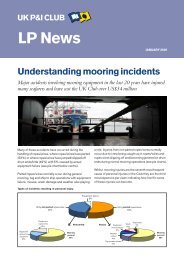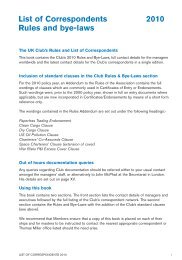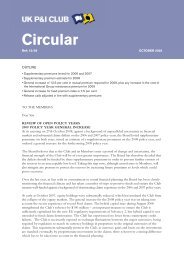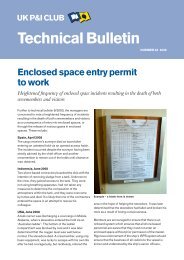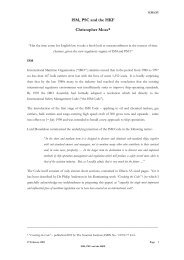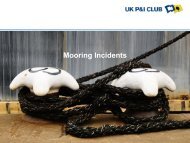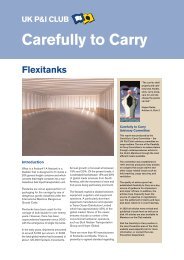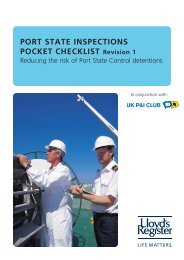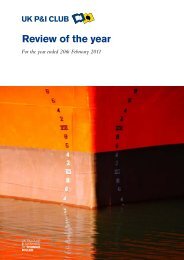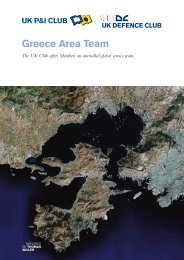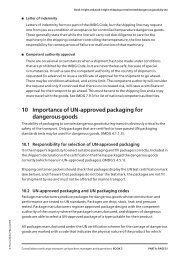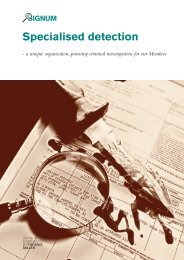Biofuels - UK P&I
Biofuels - UK P&I
Biofuels - UK P&I
Create successful ePaper yourself
Turn your PDF publications into a flip-book with our unique Google optimized e-Paper software.
However, there is the potential for FAME cargoes<br />
shipped from a warm, humid climate to extremely cold<br />
conditions, if the correct measures for heating the<br />
cargo are not applied, to form unwanted waxy<br />
precipitates which may lead to specification failure or<br />
pumping problems.<br />
As has been mentioned previously, it is generally<br />
recognised that FAMEs produced from vegetable oils<br />
with relatively high proportions of unsaturated fatty<br />
acids, for example, soybean oil, will have better coldtemperature<br />
properties than FAMEs produced from<br />
vegetable oils with high proportions of saturated fatty<br />
acids, such as palm oil. It is therefore vital that the<br />
correct heating instructions are issued and followed –<br />
an understanding of the nature of the FAME will impact<br />
upon the necessary heating instructions – this should<br />
be borne out by the appropriate research into the origin<br />
of the FAME and indicated by the results of any preshipment<br />
testing.<br />
FOSFA International (The Federation of Oils, Seeds<br />
and Fats Associations Ltd) has now included FAME<br />
products in its published heating recommendations:<br />
100 ppm maximum FAME content (DEFSTAN 91-91<br />
Issue 6).<br />
In May 2008 a number of jet fuel storage tanks at<br />
Kingsbury supply terminal and Birmingham Airport were<br />
quarantined after it was discovered that samples of the<br />
jet fuel in question contained up to 20 ppm of FAME.<br />
The cause of the contamination is thought to have<br />
been as a result of mixing of jet fuel with B5 diesel in<br />
the distillate manifold at Kingsbury terminal. As an<br />
indication of the very small quantities needed to cause<br />
such a contamination, the 5 ppm specification limit<br />
would be equivalent to just 1 litre of B5 diesel in 10,000<br />
litres of jet fuel.<br />
When vessels may potentially carry jet fuel cargoes<br />
following on from FAME or FAME/diesel blends, the JIG<br />
recommends that care must be taken with tank<br />
cleaning and flushing and draining common lines<br />
including sea or jetty loading lines. From experience,<br />
they suggest that switching from a B5 to jet fuel<br />
requires at least a hot water tank wash (but preferably<br />
also an intermediate FAME-free cargo) to remove<br />
FAME residue. Switching from neat FAME to jet fuel<br />
Oil Type Temperature during voyage Temperature at discharge<br />
Min ( o C) Max ( o C) Min ( o C) Max ( o C)<br />
FAME from<br />
Maize/Rapeseed/Soya/Sunflower<br />
Ambient<br />
Ambient<br />
FAME from<br />
Coconut/Palm/Palm Kernel/Tallow<br />
25 30 30 40<br />
FAME contamination of jet fuel: FAME is a surface<br />
active material and can adsorb onto the walls of tanks<br />
or pipelines and de-adsorb into subsequently carried<br />
products. This can be an issue where multi-product<br />
pipelines or storage tanks are utilised, or where ships<br />
carry jet fuel cargoes after carrying FAME/diesel<br />
blends.<br />
The latest DEFSTAN 91-91 jet fuel specification states<br />
that jet fuel containing less than 5 parts per million<br />
(ppm) FAME can be considered acceptable for use,<br />
that is, can be considered as being free from any<br />
FAME. Full inclusion of this specification limit into the<br />
DEFSTAN 91-91 standard is pending on the<br />
development of a suitable test method to accurately<br />
identify FAME in jet fuel at this level. A test program<br />
conducted by the Joint Inspection Group (JIG) tested<br />
jet fuel dosed with various FAMEs up to 400 ppm and<br />
found no significant affect on specification test results,<br />
and the inclusion of the 5 ppm maximum limit into the<br />
DEFSTAN 91-91 standard has been granted on the<br />
basis that the aviation industry is working towards a<br />
requires particular care and some advocate at least<br />
three intermediate (FAME free) cargoes plus the hot<br />
water wash before loading jet fuel (source: JIG Bulletin<br />
No. 21).<br />
As 5 ppm is such a low level of contamination, there is<br />
the potential for erroneous results to be produced from<br />
inaccuracies in the test methods or incorrect sample<br />
handling. The DEFSTAN 91-91 standard suggests that<br />
the currently specified method of flushing sample<br />
containers three times for jet fuel samples may not be<br />
sufficient to remove traces of FAME, which may even<br />
be transferred from contaminated gloves. This could<br />
potentially lead to false positive detection of FAME in<br />
actually on-specification material, resulting in<br />
erroneous claims being made. It is therefore<br />
recommended that new sample containers and new<br />
gloves are used when sampling jet fuel cargos.<br />
For products tankers carrying multiple products, the<br />
danger of inadvertently contaminating a cargo of jet<br />
fuel with traces of FAME is a very real risk, even if it




